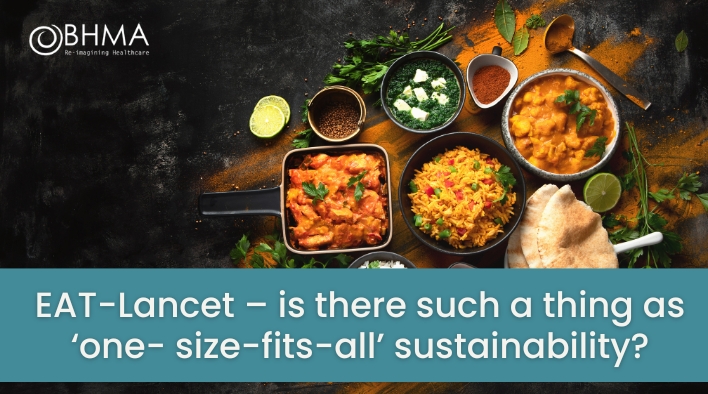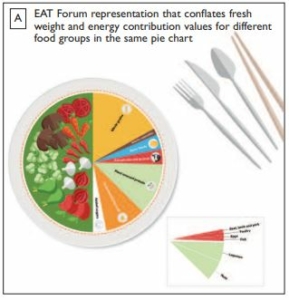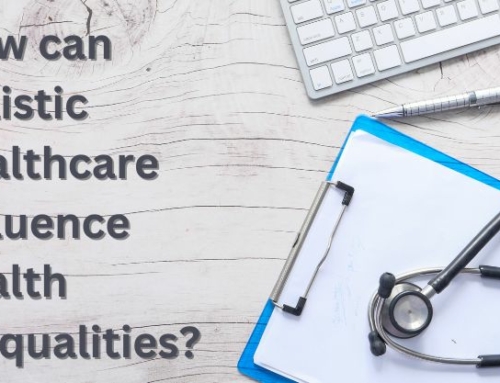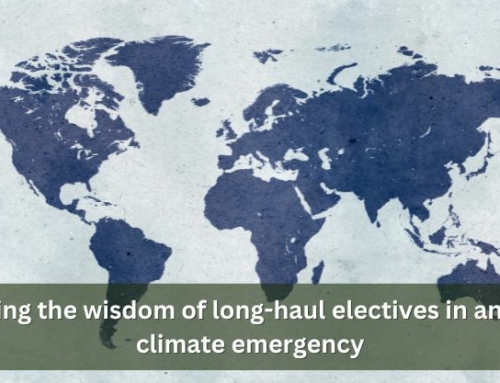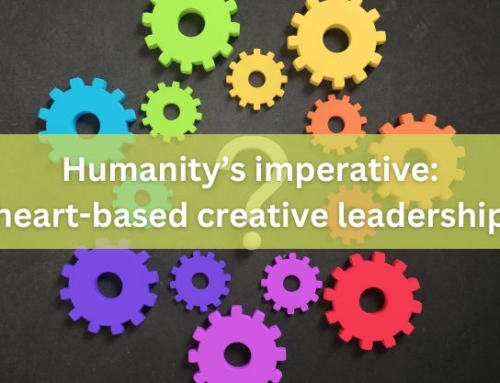EAT-Lancet – is there such a thing as ‘one- size-fits-all’ sustainability?
Robert Verkerk, Founder, executive and scientific director, Alliance for Natural Health International
Published in JHH16.3 – The Real Food Issue
It was an honour to present on this subject at the inaugural Real Food Gathering in April 2019, in a marquee on an organic farm in the wilds of the Glastonbury Valley in Somerset, in the midst of howling gales gifted by Storm Hannah. Over the last four decades, as both an academic and a campaigner, I have explored sustainability as applied to the environment, food production systems and human health. I have worked in diverse settings in Europe, sub-Saharan Africa, Central Asia, South-East Asia,Australia and the US. Insights from this work make me deeply concerned about the centralised, integrated approach proposed by EAT-Lancet that has the potential to benefit the world’s largest agrifood businesses more than either the natural environment or human health.
Introduction
January 2019 saw the publication of a Lancet Commission study that attempted to provide a global solution for dietary and planetary sustainability (Willett et al, 2019). The 47-page, 357-reference article, Food in the Anthropocene: the EAT-Lancet Commission on healthy diets from sustainable food systems, was a product of more than two years of deliberation by a Lancet Commission led by Harvard’s Professor Walter Willett and Stockholm Resilience Centre’s Professor Johan Rockström. They were supported by 17 scientific experts and 20 co-authors. The work was carried out in conjunction with the Norway-based EAT Forum (2019a), a non-governmental organisation ‘dedicated to transforming our global food system through sound science, impatient disruption and novel partnerships’ (EAT Forum, 2019b).
The EAT-Lancet Commission proposes a global transformation of food systems that set boundaries, limits and estimates for foods humans should eat and what foods should be cultivated in order to nurture both human health and the environment.
The proposal is deemed fit for the expected 10 billion population expected by 2050. The EAT-Lancet report sought to provide an integrated framework, a series of scientific targets, and a battery of soft and hard levers that should be used by policy[1]makers, the food industry, agricultural producers and the global public to help catalyse a transition toward sustainable food consumption and production patterns.
While the report was widely acclaimed by the world’s media, criticisms have subsequently emerged, including by the Sustainable Food Trust (2019), through my own critique (Verkerk, 2019), and by a subsequent decision by the World Health Organization to withdraw its support (Torjesen, 2019).
While there are many aspects of the EAT-Lancet report that are widely agreed, the primary purpose of this paper is to focus on areas of uncertainty, weakness, controversy or disagreement. Ultimately, the goal is to encourage debate so that rational, proportionate, individualised and location-specific ways forward can be established for both producers and consumers in different parts of the world.
The planetary health diet and human health implications
The EAT-Lancet Commission proposes a universally[1]applicable daily reference diet, referred to by the EAT Forum as the ‘planetary health diet’, that includes target intakes as well as ranges for eight distinct food groups (Table 1, opposite)
Among the reference diet’s most notable features are:
- Average proposed daily intakes for adults are given for eight food groups (incorrectly referred to as ‘macro[1]nutrients’) along with wider intake ranges to take into account social and cultural differences and diversity.
- Zero to relatively small amounts of meat are proposed (an average of 43g of beef, lamb, pork and poultry, comprising 3.7% of daily energy). This contrasts with present levels of meat consumption in the US of 128g a day (Daniel, 2011).
- The reference diet proposes a greater energy ‘allowance’ for sugar (120 kcal) than for beef, lamb, pork, chicken, other poultry, and eggs combined (111kcal energy).
- The proposed ‘added sugars’ allowance is the equivalent to more than seven teaspoons of added sugar every day (about 5% of daily energy intake).
- The reference diet proposes limited intakes of starchy vegetables, contrary to most current government guidelines.
- Very limited intake of saturated fats (added animal fats limited to 5g a day, equivalent to 1.4% of daily energy) are advised.
- The report proposes that palm oil, currently the second most commonly consumed dietary fat worldwide, should be limited to a maximum of just 6.8g a day (2.4% of daily energy).
- The proposed substitution of plant oils for animal fats will probably lead to n-6 to n-3 polyunsaturated fatty acid (PUFA) ratio that is strongly n-6 dominant given the lack of stipulated n-3 sources and the high n-6 content of unsaturated plant oils.
- The reference diet proposes a surprisingly low average ratio of vegetables to fruit (fresh weight) of 3:2, although a maximum of 6:1 is possible if the maximum intake of vegetables and the minimum of fruit shown in the ranges is consumed.
- It recommends a 32% contribution of daily energy from whole grains (34% from all starchy carbohydrates).
- It proposes only 8% of the daily energy contribution from all vegetables and fruit.
- The report proposes the addition of an average of 250ml a day of whole milk or derivative equivalents of dairy products (equivalent to about 25–40g of cheese), although it also allows for zero intake for those who are dairy intolerant.
While the EAT-Lancet report proposes significant reductions in consumption of red meat, sugars and highly refined carbohydrates, the proposed high intakes of n-6 relative to n-3 PUFAs, grains and starchy carbohydrates are not substantially dissimilar from current eating patterns in industrialised countries such as the UK (NDNS, 2018).
Furthermore, the presentation of the reference diet by the EAT Forum (EAT Forum, 2019c) is misleading. In its diagrammatic representation (Figure 1A), fruit and vegetables are denoted by fresh weight, and in the same figure, the remaining seven food groups are shown by energy contribution, the mixing of units in the same figure being misleading. Figures 1B and 1C represent the EAT-Lancet reference diet by fresh weight and energy contribution, respectively. These latter diagrams show that the reference diet is relatively close to current government guidelines, that are described by Harcombe (2017) as being designed more for food industry wealth than for public health. As shown by the latest data on adult consumption patterns (NDNS, 2018), compliance with the guidelines has also improved significantly since 2012 (Harland et al, 2012), yet obesity, type 2 diabetes and related conditions have continued to soar.
Taken together, it is unlikely that the escalating rates of non-communicable diseases, particularly in relation to heart disease, obesity and type 2 diabetes, could be reversed with the proposed dietary pattern which could hardly be described as ‘anti-inflammatory’ (Biobaku et al, 2019).
Furthermore, the reference diet is based on 2,500 kcal (10,460 kJ) daily intakes, which does not take into account caloric restriction which has been linked to reduced incidence of preventable chronic diseases (Lee and Longo, 2016). The EAT-Lancet report also avoids any consideration of food frequency or intermittent fasting, the ‘how’ we eat having been shown to be at least as important as ‘what’ we eat (Miller et al, 2018; Templeman et al, 2019). Furthermore, with carbohydrate intakes, maintained at around 35% of total energy intake, the EAT-Lancet reference diet ignores extensive clinical evidence and emerging published evidence for the benefits of carbohydrate[1]restricted diets, especially among overweight, obese, type 2 diabetic or prediabetic individuals (Zafar et al, 2019).
However, many of these assumptions are based on the average values proposed, and not the ranges. It is therefore important to evaluate the potential health implications of different interpretations of the reference diet, based on the flexibility offered by the ranges. It also worth pointing out that widespread public adoption of dietary patterns at the limits of these ranges may alter quite dramatically the relevance of the EAT-Lancet Commission’s findings as well as its recommendations. Examples include widespread consumption of the minimum amount (200g per capita) of all types of vegetables per day, or maximum consumption of animal protein sources (211g per capita daily from beef, lamb, pork, chicken and other poultry, eggs and fish).
Exploring the flexibility of the planetary health diet
We conducted a detailed scenario analysis in which the nutrient composition of three types of ‘flexitarian’ 1 and vegan diets for which specific foods were selected in amounts compliant with the reference diet were compared (Verkerk, 2019). Nutrient contents were determined from data in the USDA National Nutrient Database for Standard Reference (https://ndb.nal.usda.gov). The three types were characterised as ‘basic’ (assuming typical interpretations, using average amounts), ‘lower carb’ (common and popular among those with metabolic issues and seeking weight reduction) and ‘higher protein, physically active’ (given that the average protein stipulation in the reference diet is inadequate and has not been optimised for physically active individuals (Slater and Phillips, 2011; Stellingwerff et al, 2011).
The following conclusions could be drawn from the scenario analysis:
- Protein intakes ranged from a minimum of 8.7% of total energy for the ‘higher protein, physically active’ vegan diet to 11.3% of total energy for the ‘lower carb’ ‘flexitarian’ diet.
- The protein intakes for all three vegan scenarios (based on a 70kg adult) were below the consensus levels set for adult humans established by an international expert group in 2007 (Joint WHO/FAO/UNU Expert Consultation 2007).
- Despite including the minimum amounts proposed in the reference diet, the protein intake in one of the vegan scenarios (‘lower carb’) was below the level considered adequate even by the EAT-Lancet authors.
- The amino acid profiles in the vegan scenarios may be incomplete for some individuals, particularly those who are immunologically challenged, with a higher arginine requirement (Daly et al, 1990).
- Total energy intake from carbohydrates could be varied by different dietary compositions from 33% (‘flexitarian’ ‘higher protein, physically active’) to 52% of total energy (vegan, ‘basic’).
- The contribution of daily energy from whole grains could be varied from 20% (flexitarian ‘higher protein, physically active’) to 35% (flexitarian, ‘basic’), the latter, not the former, being close to the EAT-Lancet target of 32%
- Given the relatively large intakes of plant foods, dietary fibre intakes in all scenarios readily met the 30g per day target (range: 35–53g) set in the landmark study by (Reynolds et al, 2019).
- The vegan diets are likely to be deficient in a wide range of micronutrients, including vitamin A (retinol) (Kristensen et al, 2015), haem iron (Miller, 2013), vitamin B12 (Gilsing et al, 2010) and long-chain omega[1]3 fatty acids (notably eicosapentaenoic acid (EPA), and docosahexaenoic acid (DHA) (Burdge et al, 2017).
- High levels of phytic acid may prevent adequate absorption of zinc, copper and iron (Lim et al, 2013)
- Replacing animal-based foods with vegan ones may illicit adverse reactions in sensitive individuals, owing to increased intakes of gluten (Schnedl et al, 2018), anti[1]nutritional factors such as lectins (Miyake et al, 2007), phytate (Schlemmer et al, 2009), goitrogens (Felker et al, 2016) and oxalates (Prezioso et al, 2015).
- The EAT-Lancet recommendations do not adequately take into account adaptations of specific sub-populations to particular diets and the potential impacts on the microbiome, especially of the gut (Gupta et al, 2017) that can be associated with dietary transformation.
- The Lancet-Commission authors continue to maintain an anti-saturated fat stance, contradicting the recent changes in the scientific consensus on the subject (Fattore and Massa, 2018; Zhu et al, 2019). The authors also do not adequately address the evidence for the pro[1]inflammatory nature of diets in which a high dietary n-6: n-3 polyunsaturated fatty acid (PUFA) ratio contribute to metabolic diseases (Torres-Castillo et al, 2018).
- The EAT-Lancet authors make a strong case for increased use of oilseed rape (canola) because of its provision of essential fatty acid alpha-linolenic acid (ALA). Twenty-five per cent of the world’s oilseed rape is genetically modified, the vast majority of this being grown in Canada, the US and Australia (Belter, 2016), with a consequent increase in herbicide-resistant weeds (Fernando et al, 2016).
- The data that the EAT-Lancet Commission has relied on to draw its conclusions are based on long-term studies involving mortality (not morbidities or comorbidities), many of which are based on consumption patterns that precede the era of widely available globalised, ultra[1]processed foods. Additionally, there are major, ongoing dietary transitions associated with increasingly urbanised populations, such as the consumption of increasing amounts of food outside of the home, which generally has been shown to be detrimental to health compared with food preparation in the home (Nago et al, 2014). Accordingly, the findings may not be relevant to consumption patterns required to reduce morbidities and mortalities in the current or future eras.
Greening agriculture?
The EAT-Lancet’s environmental protection and agricultural sustainability goals are laudable. They include climate change mitigation, conversion of agricultural systems from net carbon emitters to net carbon sinks, water conservation, improved nutrient recycling, and enhancement of biodiversity. All of this, says the EAT[1]Lancet Commission, is to be achieved through great strides in efficiency in the use of fertilisers and land – with no additional land use over that presently used for agriculture.
Despite growing awareness about the health of plant[1]based diets and adverse impacts of factory farming of animals over the last decade or more, there has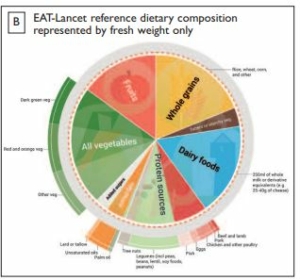 been no slowing in demand for livestock products, a trend that is strongly linked to growing affluence. The World Health Organization (WHO) projects that annual meat production will increase to 376 million tonnes by 2030, a 72% increase from 1999 (WHO, 2019).
been no slowing in demand for livestock products, a trend that is strongly linked to growing affluence. The World Health Organization (WHO) projects that annual meat production will increase to 376 million tonnes by 2030, a 72% increase from 1999 (WHO, 2019).
The proposal to halve meat consumption globally met with an expected negative reaction from the meat industry. However, the EAT-Lancet authors – as is often the case with desk-based research projects reliant on macro data – have failed to take into account the profound differences that livestock production systems can have depending on whether they operate as part of industrial farming or agroecological systems.
Marginal lands
Parts of the USA, Russia and Australia, for example, have relatively large amounts of marginal land that is suitable for grazing, but not for arable or horticultural production. In fact, the concept of ‘marginal land’, in which land is considered marginal for agriculture, but vital for grazing, is integral to any large-scale, holistic, sustainable agro[1]ecosystems model (Shahid and Shankiti, 2013). Dry land, much of it viewed as marginal, represents 45% of the world’s land area and the role of livestock to aid the ‘upcycling’ of such land is viewed as increasingly important for the future of food, people and planet. Ironically, as the Global Dry Land Alliance (GDLA) member countries are only too well aware, the trend towards salinisation and desertification of dry lands is actually reducing available arable land, and increasing land suitable for grazing and restoration for mixed uses.
Maintaining ideology, avoiding reality
The EAT-Lancet report avoids some of the most thorny questions around intensification of agriculture production systems, including the centralisation of agricultural resources (eg seeds, fertilisers), increased use of genetically modified (GM) crops and associated pesticides (eg glyphosate), and the impacts of pesticides on non-target organisms including pollinators and humans. These were among the issues considered as crucially significant in the five-year, seminal findings of the International Assessment of Agricultural Knowledge, Science and Technology for Development (IAASTD, 2009) which, based on five years of research by 400 scientists from 60 countries, favoured transition towards decentralised, locally-adapted, agro[1]ecological models.
There remains considerable confusion over the extent of agriculture’s contribution to greenhouse gas emissions, the EAT-Lancet report authors relying on Vermeulen et al’s (2012) estimate of ‘up to 30%’ contribution to greenhouse gas emissions. By contrast, the US Environmental Protection Agency (EPA, 2018) estimates the contribution at just 9% of the total amount, with 28% linked to transportation, 22% to industry and 28% to electricity generation. The contribution from live[1]stock is estimated at just 4.2%, comprising 2.2% from beef, 1.4% dairy, 0.5% swine and 0.1% from poultry.
By contrast, New Zealand, with just 4.6 million human population and more than twice that many cattle, is estimated to produce 46% of its greenhouse gases from agriculture, with electricity production contributing nearly the same amount, at 42% (NZ Ministry for the Environment, 2014). So while per capita greenhouse gas emissions are a stunning 16 times over the global sustainable rate of 1 ton of CO2-equivalent per person, New Zealand, by virtue of its small population, is well outside the top 20 greenhouse gas emitting countries. In order to reaffirm the need for prioritisation, New Zealand’s emissions represent just 1.7% those of China and 3.4% those of the US.
Global versus local
Given that a central tenet of EAT-Lancet is to reduce global consumption of red meat by over 50% ostensibly to reduce greenhouse gas emissions, we calculated, using FAO data, the relative impact of animal protein intake per country, taking into account per capita animal protein intake and population sizes (Verkerk, 2019). This analysis showed that just three countries (China, the US and India) contributed to 67% of the global impact, assuming equivalence of impact per gram of animal protein consumed. This emphasises the need to focus on regional and local solutions, as opposed to global ones that inevitably encourage further globalisation and centralisation of resources, a trend being widely considered as counter to environmental, cultural and social diversity and sustainability (der Ploeg, 2012).
Concluding remarks
Views about the most sustainable nutritional and agricultural practices are increasingly being informed by desk-based researchers and policymakers with strong belief systems and ideologies, but who have little practical experience either of nutrition or sustainable agriculture in diverse ecotypes.
Data on which views are based is often derived from meta-analyses or systematic reviews, whose original data may be many decades old and so no longer relevant to current or future scenarios. During the analysis and interpretation of results, association is often incorrectly taken to imply causation. When the results are published, media channels that support the ideologies spin the findings further – and the public does its best to pick up the pieces and integrate them with its own knowledge, experience and belief systems.
The EAT-Lancet project is, in our opinion, a case in point. The much-publicised research paper by Poore and Nemecek (2018), which has been used as a justification to vilify animal-based foods, is another. With an ideology in place, it is very easy to look past the full range of factors that require consideration if truly sustainable approaches are to be found. That might include, for example, the consideration of biodiversity loss (eg small mammals, birds, soil organisms) attributable to soil degradation, herbicide, fertiliser and pesticide use, as well as the destruction of hedgerows and borders, all in the name of expanding large-scale arable monocultures intended for human consumption.
Another major issue with the big picture, globalised approach that occurs when scientists and policy makers get together in the manner of this Lancet Commission, is that they work with averages. In doing so, the subtleties, vagaries, mysteries and wonders of outliers are omitted from their analyses. Their lack of practical experience of such examples – whether it is the resolution of auto[1]immune conditions through the removal of certain types of plant food from the diet, or the restoration of marginal grasslands through the re-introduction of livestock – means they remain invisible.
Once an ideology takes hold – as is the case with concepts such as peak livestock and the perceived need to globally transition from animal to plant-sourced proteins (Harwatt, 2018) – momentum can gather quickly. If policy measures including taxes on foods deemed unhealthy or bad for the environment are imposed, the process of transition is likely to accelerate. In this case, it is essential that the approach – and the evidence that underpins it – is sound. In many cases, contrary to the bold assertions made by the EAT-Lancet authors, the data are far from certain.
The EAT-Lancet report, in effect, vilifies meat consumption. However, even accepting the arguments made, meat eating is not the problem per se – it is excessively cheap meat that is the problem, where the cost of the meat does not adequately take into account the true cost of its production in environmental terms. This includes how different types of animal production systems act as sources or sinks for greenhouse gases, or whether their net carbon footprints and the ecosystem services offered, including that related to the forage crops or feed that helped create the animals, have been adequately factored in.
If agro-ecological systems were to be valued for their reduced impacts on climate change, their contribution to biodiversity and reduced pollution, and in which livestock were accepted as a necessary part of these systems, a degree of meat-eating, probably significantly over the levels contemplated in the planetary health diet, would probably be tolerable. But such approaches are completely counter to the kind of industrialised animal production methods that have become de rigeur through much of the world.
The westernisation, simplification and globalisation of diets is a massive issue for both people and planet. This process, that has swept across the world ever more rapidly over the last three or so decades, is being driven as much by industry and government, as it is by consumer demand. As emphasised by research on the five blue zone regions of the world, long, healthy lives are not associated with technological advancement either of food production or healthcare systems (Buettner and Skemp, 2016). The corollary is also true. Obesity, type 2 diabetes and the primary health burdens of the 21st century, are all associated with technological advancement. Traditional diets and agricultural practices are being forgotten at an astonishing rate as adoption of technology and urbanisation gathers pace in the so-called developing nations.
For the sake of people and planet, a major international effort is urgently required to compare the net harms and benefits of different strategies relating to food production systems and consumption patterns in different regions and countries. This should include comparisons between high-input, industrial-scale farming systems for plants and animals, against low-input, sustainable systems, based on agro-ecological, nutrient-cycling principles.
As suggested by Christine King (2008), these agro-ecological systems are about reconnecting people and food, and people with people – as well as helping to create community and health resilience. Fundamental to the viability and stability of these systems is their adaptation to local environments and cultures, and their resilience in the face of climatic, social and political instability.
Such considerations are of key importance given the deficiencies of the EAT-Lancet report and the rise of the corporatocracy (Vanbergen, 2016). Equally, full account needs to be taken of the social, environmental, economic and cultural impacts of current trend tendency for control of agricultural, food production and healthcare resources into the hands of a small number of transnational corporations (George, 2015; Hendrikson et al, 2017).
References
- Belter A (2016) Long-term monitoring of field trial sites with genetically modified oilseed rape (Brassica napus L) in Saxony-Anhalt, Germany. Fifteen years persistence to date but no spatial dispersion. Genes (Basel), 7(1) pii: E3.
- Biobaku F, Ghanim H, Batra M et al (2019) Macronutrient mediated inflammation and oxidative stress: relevance to insulin resistance, obesity and atherogenesis. J Clin Endocrinol Metab, pii: jc.2018–01833.
- Buettner D, Skemp S (2016) Blue zones: lessons from the world’s longest lived. Am J Lifestyle Med, 10(5) 318–321.
- Burdge GC, Tan SY, Henry CJ (2017) Long-chain n-3 PUFA in vegetarian women: a metabolic perspective. J Nutr Sci: e58.
- Daly JM, Reynolds J, Sigal RK et al (1990) Effect of dietary protein and amino acids on immune function. Crit Care Med, 18(2 Suppl) S86–93.
- Daniel CR, Cross AJ, Koebnick C et al (2011) Trends in meat consumption in the USA. Public Health Nutr, 14(4) 575–83.
- EAT Forum (2019a) EAT Forum website. www.eatforum.org (accessed 5 August 2019).
- EAT Forum (2019b) EAT Forum – who we are. Available at: https://eatforum.org/about/who-we-are (accessed 5 August 2019).
- EAT Forum (2019c) Healthy diets from sustainable food systems. Summary report. Available at: https://eatforum.org/content/uploads/ 2019/01/EAT-Lancet_Commission_Summary_Report.pdf (accessed 5 August 2019).
- EPA (2018) Sources of greenhouse gas emissions. Available at: https://www.epa.gov/ghgemissions/sources-greenhouse-gas-emissions. (accessed 5 August 2019).
- Fattore E, Massa E (2018) Dietary fats and cardiovascular health: a summary of the scientific evidence and current debate. Int J Food Sci Nutr, 69(8) 916–927.
- Felker P, Bunch R, Leung AM (2016) Concentrations of thiocyanate and goitrin in human plasma, their precursor concentrations in brassica vegetables, and associated potential risk for hypothyroidism. Nutr Rev, 74(4) 248–58.
- Fernando N, Manalil S, Florentine SK et al (2016) Glyphosate resistance of C3 and C4 weeds under rising atmospheric CO2. Front Plant Sci, 7, 910.
- George S (2017) Shadow sovereigns: How global corporations are seizing power. London: John Wiley & Sons.
- Gilsing AM, Crowe FL, Lloyd-Wright Z et al (2010) Serum concentrations of vitamin B12 and folate in British male omnivores, vegetarians and vegans: results from a cross-sectional analysis of the EPIC-Oxford cohort study. Eur J Clin Nutr, 64(9) 933–9.
- Gupta VK, Paul S, Dutta C (2017) Geography, ethnicity or subsistence[1]specific variations in human microbiome composition and diversity. Front Microbiol, 8, 1162.
- Harcombe Z (2017) Designed by the food industry for wealth, not health: the ‘Eatwell Guide’. Br J Sports Med, 51(24) 1730–1731
- Harland J, Buttriss J, Gibson S (2012) Achieving eatwell plate recommendations: Is this a route to improving both sustainability and healthy eating? Nutr Bull, 37, 324–343.
- Harwatt H (2019) Including animal to plant protein shifts in climate change mitigation policy: a proposed three-step strategy. Climate Policy, 19(5) 533–541.
- Hendrickson MK, Howard PH, Constance DH (2017) Power, food and agriculture: implications for farmers, consumers and communities. EconStor Preprints 171171. Kiel, Germany: Leibniz Information Centre for Economics.
- IAASTD (2009) Agriculture at a crossroads. International Assessment of Agricultural Knowledge, Science and Technology for Development, Sub-Saharan Africa (SSA) Report. Available at: www.fao.org/fileadmin/ templates/est/Investment/Agriculture_at_a_Crossroads_Global_Report_ IAASTD.pdf (accessed 5 August 2019).
- Joint WHO/FAO/UNU Expert Consultation (2007) Protein and amino acid requirements in human nutrition. World Health Organ Tech Rep Ser, (935) 1–265
- King CA (2008) Community resilience and contemporary agri ecological systems: reconnecting people and food, and people with people. Sys Res Behav Sci, 25(1) 111–124
- Kristensen NB, Madsen ML, Hansen TH et al (2015) Intake of macro- and micronutrients in Danish vegans. Nutr J, 14, 115
- Lee C, Longo V (2016) Dietary restriction with and without caloric restriction for healthy aging. F1000Res, 5. pii: F1000 Faculty Rev–117.
- Lim KH, Riddell LJ, Nowson CA et al (2013) Iron and zinc nutrition in the economically-developed world: a review. Nutrients, 5(8) 3184–211.
- Miller JL (2013) Iron deficiency anemia: a common and curable disease. Cold Spring Harb Perspect Med, 3(7) pii: a011866.
- Miller VJ, Villamena FA, Volek JS (2018) Nutritional ketosis and mitohormesis: potential implications for mitochondrial function and human health. J Nutr Metab, 11, 2018:5157645.
- Miyake K, Tanaka T, McNeil PL (2007) Lectin-based food poisoning: a new mechanism of protein toxicity. PLoS One, 2(8) e687.
- Nago ES, Lachat CK, Dossa RA et al (2014) Association of out-of-home eating with anthropometric changes: a systematic review of prospective studies. Crit Rev Food Sci Nutr, 54(9) 1103–16.
- NDNS (2018) National Diet and Nutrition Survey – results from years 7 and 8 (combined) of the rolling programme (2014/2015 to 2015/2016). Available at: https://assets.publishing.service.gov.uk/government/ uploads/system/uploads/attachment_data/file/699241/NDNS_results_ye ars_7_and_8.pdf (accessed 5 August 2019).
- NZ Ministry for the Environment (2014) New Zealand’s greenhouse gas inventory 1990–2012 and net position snapshot April 2014. INFO 709. Available at: www.mfe.govt.nz/publications/climate-change/ new-zealands-greenhouse-gas-inventory-1990–2012-and-net-position (accessed 5 August 2019).
- der Ploeg JD (2012) The new peasantries: struggles for autonomy and sustainability in an era of empire and globalisation. London: Routledge.
- Poore J, Nemecek T (2018) Reducing food’s environmental impacts through producers and consumers. Science, 360(6392) 987–992.
- Prezioso D, Strazzullo P, Lotti T et al (CLU Working Group) (2015) Dietary treatment of urinary risk factors for renal stone formation. A review of CLU Working Group. Arch Ital Urol Androl, 87(2) 105–20
- Public Health England (2018) Guidance: Eatwell Guide. Available at: www.gov.uk/government/publications/the-eatwell-guide (accessed 5 August 2019).
- Reynolds A, Mann J, Cummings J et al (2019) Carbohydrate quality and human health: a series of systematic reviews and meta-analyses. Lancet, 393(10170) 434–445.
- Schlemmer U, Frølich W, Prieto RM, et al (2009) Phytate in foods and significance for humans: food sources, intake, processing, bioavailability, protective role and analysis. Mol Nutr Food Res, 53 Suppl 2, S330–75
- Schnedl WJ, Lackner S, Enko D et al (2018) Non-celiac gluten sensitivity: people without celiac disease avoiding gluten – is it due to histamine intolerance? Inflamm Res, 67(4) 279–284.
- Shahid SA, Al-Shankiti A (2013) Sustainable food production in marginal lands – Case of GDLA member countries. Int Soil Water Conserv Res, 1(1) 24–38.
- Sustainable Food Trust (2019) ‘EAT-Lancet report’s recommendations are at odds with sustainable food production’ (17 January 2019). Available at: https://sustainablefoodtrust.org/articles/eat-lancet-reports[1]recommendations-are-at-odds-with-sustainable-food-production (accessed 5 August 2019).
- Templeman I, Gonzalez JT, Thompson D et al (2019) The role of intermittent fasting and meal timing in weight management and metabolic health. Proc Nutr Soc, Apr 26, 1–12 [ahead of print].
- Torjesen I (2019) WHO pulls support from initiative promoting global move to plant- based foods. BMJ 2019, 365, l1700.
- Torres-Castillo N, Silva-Gómez JA, Campos-Perez W et al (2018) High dietary -6: -3 PUFA ratio is positively associated with excessive adiposity and waist circumference. Obes Facts, 11(4) 344–353.
- Vanbergen G (2016) The rise of the corporatocracy. The European Financial Review. Available at: www.europeanfinancialreview.com/ the-rise-of-the-corporatocracy (accessed 5 August 2019).
- Verkerk R (2019) Has the EAT-Lancet Commission found a ‘win-win’ for people, food and planet? Available at: www.anhinternational.org/news /anh-intl-special-report-analysis-of-the-eat-lancet-report (accessed 5 August 2019)
- Vermeulen SJ, Campbell BM, Ingram JSI (2012) Climate change and food. Annual Review of Environment and Resources, 37, 195–222.
- WHO (2019) Global and regional food consumption patterns and trends. Available at: www.who.int/nutrition/topics/3_foodconsumption/ en/index4.html (accessed 5 August 2019).
- Willett W, Rockström J, Loken B et al (2019) Food in the Anthropocene: the EAT-Lancet Commission on healthy diets from sustainable food systems. Lancet 393(10170) 447–492
- Zafar MI, Mills KE, Zheng J et al (2019) Low-glycemic index diets as an intervention for diabetes: a systematic review and meta-analysis. Am J Clin Nutr, Aug 2, pii: nqz149.
- Zhu Y, Bo Y, Liu Y (2019) Dietary total fat, fatty acids intake, and risk of cardiovascular disease: a dose-response meta-analysis of cohort studies. Lipids Health Dis, 18(1) 91.

